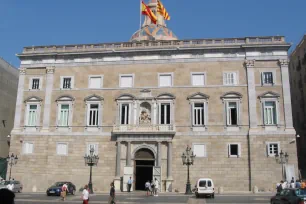The Plaça de Sant Jaume is a square in the heart of Barri Gòtic, Barcelona’s Gothic quarter. The rectangular square, laid out in 1824, marks the historical and governmental center of the city.

In the antiquity, when the city was called Barcino, the north side of the square was the site of the Roman Forum. In the fourteenth century a church was built here, the Església de Sant Jaume.
A fire in 1822 damaged the church, and it was demolished the following year to make way for a new square, which was named after the church in a sort of posthumous tribute. The church’s cemetery was moved outside the city wall, which gave city planners plenty of room for a spacious square.
The pedestrian-friendly square is often the site of festivities, celebrations and demonstrations. It is defined by the grand facades of Barcelona’s two most important government buildings: the Casa de la Ciutat and, opposite, the Palau de la Generalitat.
Casa de la Ciutat

The Casa de la Ciutat is Barcelona’s Ajuntament (City Hall). It was originally built in the fourteenth century in a Gothic style by Pere Llobet. The neoclassical facade facing Plaça de Sant Jaume dates from 1831-1847, when the city hall was renovated and expanded. The statues on either side of the main entrance depict Jaume I (James I of Aragon), who in 1249 granted Barcelona the rights to elect their own city council, and Joan Fiveller, a fifteenth-century Catalan leader who in his function as head of the city council opposed royal authoritarianism.
To get an idea of what the city hall looked like in the Middle Ages, walk around the corner in the Carrer de la Ciutat. Here you can see the former front facade, built between 1399 and 1402 by Arnau Bargués. Above the entrance is a statue of the archangel Raphael, created in 1400.
The current main entrance on Plaça de Sant Jaume leads to a sixteenth-century courtyard with two staircases. Inside, the most interesting room is the Saló de Cent (Room of the One Hundred), created in 1373 by Pere Llobet for the Council of One Hundred that assembled here until 1714. The hall has a wooden roof supported by large round arches. Wooden benches line the walls of the hall, and beautiful chandeliers hang from the ceiling.
Palau de la Generalitat

Opposite the city hall is the Palau de la Generalitat, originally built between 1418 and 1425 to house the Diputació del General de Catalunya, the Catalan government. The Gothic structure was built under the lead of Marc Safont. Its original main facade, on Carrer Honorat, features a relief of Sant Jordi (Saint George), the patron saint of Catalonia.
In the late sixteenth century, the building was expanded towards Plaça de Sant Jaume. The current main facade, facing the square, was completed in 1596 by Pere Blai in Renaissance style. Above the entrance is a large statue of St. George and the dragon.
It’s the interior of the Palau de la Generalitat however that is the most interesting. Unfortunately, the building is rarely open to visitors. But if you manage to get inside, make sure you don’t miss the Pati dels Tarongers (Orange Tree Patio), a beautiful courtyard in late Gothic style located on the first floor. It was created in the sixteenth century by Pau Mateu and Tomas Barsa. The bell tower overlooking the courtyard was built in 1568 by Pere Ferrer.
There are many magnificent rooms inside the Palau de la Generalitat. One of the most impressive is the Saló de Sant Jordí, a vaulted hall decorated with twentieth-century murals. The nearby Capella Sant Jordi has intricate wall carvings. The keystone of its vaulted roof is decorated with a gilded statue of St. George.
- Next: CosmoCaixa
- More Sights & Attractions in Barcelona

